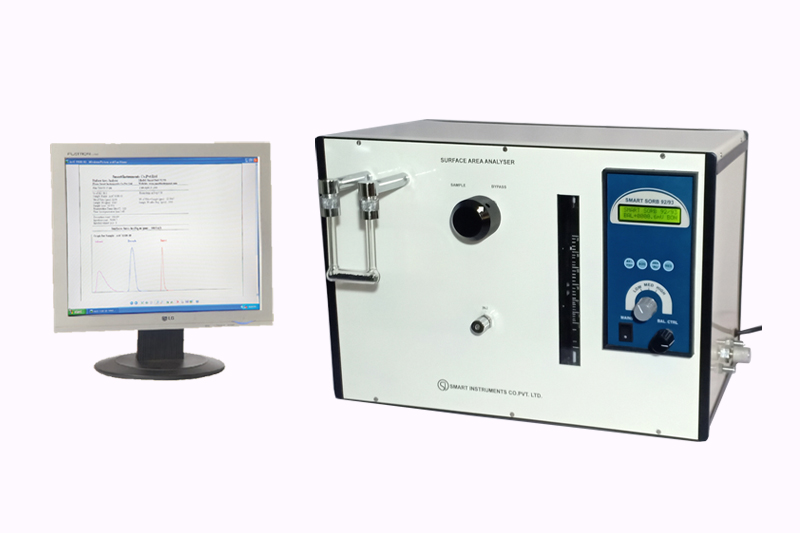Welcome to SMART INSTRUMENTS COMPANY PVT. LTD.

Surface Area is an intrinsic property of powdered porous materials that can reveal important information regarding the usefulness of a material for an application. Surface area plays critical role in the bio-availability of Pharmaceuticals, dispersion of dyes, adsorption capacity of carbon and many more.
By means of Physical adsorption, Surface Area can be calculated since physically adsorbed molecules are not restricted to specific sites and are free to cover the entire Surface. This process is reversible. Typically nitrogen gas is adsorbed at cryogenic temperatures (liquid nitrogen). Based on the amount of gas adsorbed (adsorbate) at a given pressure, the BET equation is used to calculate the number of adsorbed gas molecules that would be required to form a monolayer on the surface. With knowledge of the cross - sectional area of the gas molecule adsorbed, the Surface Area can be easily calculated.
The instrument Smart Sorb 93 is based on the theory first proposed by Brunaur,
Emmet and Teller known as BET theory. The equation for this was modified for fast
measurement by dynamic method. In our instrument a gas mixture of 70% He & 30%
N2 (i.e. partial pressure of 0.3) is passed over the sample. N2 in this mixture gets
adsorbed over the surface of the sample at liquid nitrogen temperature and forms a
single molecular layer over the surface of sample. This adsorbed N2 is then measured
to calculate surface area of the sample.
We are using dynamic method for measurement of surface area. In this method
gas mixture (approximately 30% nitrogen and 70% helium) continuously flows over
the sample. The sample is dipped in liquid nitrogen. At liquid nitrogen temperature (-
196°C) nitrogen in this flow gets adsorbed on the surface and forms a mono layer on
the surface. This adsorbed N2 is allowed to desorbed by bringing the sample to room
temperature. This desorbed nitrogen is proportional to the surface area and so measured
to calculate surface area by using following equation.
The BET equation needs some physical parameters such as room temperature,
partial pressure of the gas mixture etc. The final derived equation is,
Surface Area , Ss = (4.35/ W) (NCs x Vn / NCn) [273 / (273+t)](1-P/Po)
Where,
W = Weight of the sample in gms.
NCs = number of counts measured on our instrument which are
proportional to the quantity of desorbed nitrogen.
Vn = This is the amount of N2 in c.c.s injected for the purpose of
calibration.
NCn = number of counts measured which are proportional to the
injected N2
t = Room temperature
P/Po = Partial pressure of adsorbed gas. Approximately it is 0.3 for
70% He & 30%N2
Note: The calibration is necessary since all the readings on our instrument are relative.
This calibration is done after every sample but if all the parameters such as gas flow,
temperature is kept constant throughout the experiment then calibration can be done
only once.
For Quality Control and Research Laboratory -
